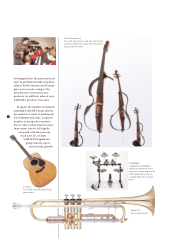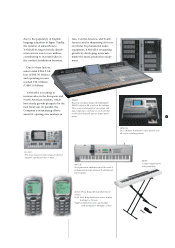Yamaha 2001 Annual Report Download - page 20
Download and view the complete annual report
Please find page 20 of the 2001 Yamaha annual report below. You can navigate through the pages in the report by either clicking on the pages listed below, or by using the keyword search tool below to find specific information within the annual report.
s production
inherently
places a burden
upon the envi-
ronment, the
YAMAHA Group considers the issue
of environmental protection to be
one of the major managerial challenges
it faces today. YAMAHA’s Environ-
mental Committee is challenging
itself to consider how the Company’s
operations affect the environment
and is working to protect it in ways
that include the development of
green technologies and products.
In October 2000, the Company
began issuing an environmental
report to ensure adequate disclosure
of its environment-related activities.
This report makes YAMAHA’s en-
vironmental program transparent to
investors and shareholders, inviting
them to assess the suitability of the
Company’s activities in this area.
The YAMAHA Group has estab-
lished goals aimed at acquiring ISO
14001 certification for all its opera-
tions by March 2003. The Company
has already acquired certification for
all domestic production sites and, by
creating an environmental manage-
ment system for each member of
the YAMAHA Group abroad,
steady progress is being made
toward Groupwide certification.
Furthermore, the Company has
launched directives for the entire
Group to ensure the implementation
of environment-friendly systems that
take into account the full life cycle
of YAMAHA’s products. In broad
terms, YAMAHA’s business flow runs
through five main stages: product
development, procurement of parts
and materials, production processes,
product use, and disposal. In procur-
ing parts and materials, the Company
emphasizes the adoption of recyclable
materials and the development of
artificial materials that can be used
in place of natural resources. In its
production processes, YAMAHA is
working to reduce its use of chemi-
cal substances and improve produc-
tion efficiency through energy
conservation measures designed to
reduce air, soil, and water pollution.
The Company avoids using scarce
resources in instrument production,
focusing instead on such fast-grow-
ing materials as bamboo to produce
products that are easy on the envi-
ronment. Action is also being taken
to reduce or eliminate the use of
chemical pollutants, replacing them
with safer substances. In terms of
product use, YAMAHA’s audiovi-
sual products significantly reduce
power consumption while the
Company’s original Silent Instrument
Series addresses the need for reduced
noise pollution and an improved liv-
ing environment. The strength of
the electronic tones emitted from
these instruments is adjustable,
enabling users to generate full, nat-
ural acoustic sound during perfor-
mances. Also indicative of
YAMAHA’s concern for the envi-
ronment is the Company’s shift,
now well under way, to recyclable
and reusable packaging materials
for transporting products. Finally,
YAMAHA promotes recycling by
marking reusable parts for easy
identification and designing prod-
ucts to facilitate the easy removal of
reusable nickel-cadmium batteries.
The YAMAHA Group’s envi-
ronmental considerations span the
entire life cycles of its products,
from development to disposal.
Nature is the source of humanity’s
livelihood and, as a result, YAMAHA
attaches great importance to the
relationship between society and the
earth upon which it relies. In the
future, the Company will redouble
its efforts aimed at overcoming
environmental problems through
prioritized activities that ensure the
fulfillment of its societal responsi-
bilities.
18
Environmental Challenges
























